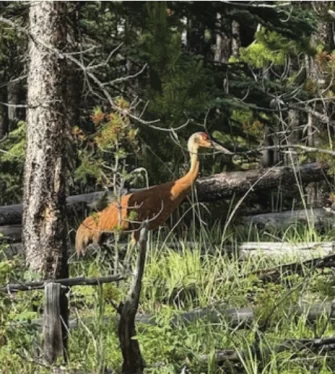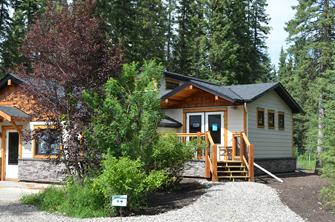October is a time to appreciate all the fall colours both on the leaves of our trees and in the migrant birds who are passing through our neighbourhoods. One of our biggest migrants that uses the Boreal Forest, Foothills and Prairies for an occasional breeding ground is the immense and prehistoric Sandhill Crane. I have yet to have the pleasure of finding one of these birds in the wild, but our dear editor Lowell ran into a breeding pair this summer.
I call it prehistoric for a few reasons. One is the first known Sandhill Crane showed up in the fossil record in Florida 2.5 million years ago, making it the oldest known living bird species. Another is that as someone who works as a prehistoric guide these massive birds look like some of their ancient dinosaur relatives very well might have. They are over a meter tall with wing spans longer than most humans are tall at 6.5 feet. They have a bald red spot above a long bill which is used to eat everything in their omnivore diet from berries, seeds, and invertebrates to small mammals and snakes. Sandhill Cranes have grey plumage as adults; however, they partake in something known as staining. This is where they rub mud into their feathers. When the mud is rich in iron, this action stains their feathers to a rusty brown colour. This can lead to some confusion when trying to identify the crane. The last reason is their call. I encourage you to play a Sandhill Crane call in a dark room and see if you don’t imagine yourself in a prehistoric rainforest. It’s a rapid call that’s part trill and part bugle.

When you come across a Sandhill Crane it is likely you will find at least two together as they mate for life and spend the entire year together. They travel from Mexico and the Southern United States up into Canada and as far as Alaska using the Central Flyway, a migration corridor that narrows around Nebraska. This impressive journey, which can be over 8000 kilometers, is done riding thermals during the day to save as much energy as possible. At night they rest literally sleeping with one eye open while the other eye and half of their brain go into a deep sleep.
If they make it through this incredible journey the pair renew their bond with calling to one another and elaborate dances showing off their wings and jumping ability. The pair will then lay two eggs and if they are lucky one chick will survive long enough to travel back south with them. Although it is not all luck, Sandhill Cranes have been known to chase off alligators (in Florida) and other predators who they think are getting too close to their family.
If you would like to help the migrating birds, please turn off your lights from 11pm to 6am for the nocturnal migrators like songbirds, and give the diurnal migrators a respectful viewing distance to help them save their energy reserves.
Photos by Lowell Harder




























